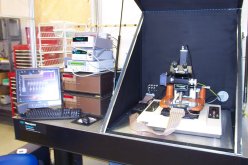High Resolution Fly's Eye
Faculty:
- John Matthews - johnm@phys.unm.edu - Professor Director
We are involved in 2 experiments in neighbouring Utah: the High Resolution Fly's Eye (HiRes) experiment HiRes in Dugway Utah, and the Pierre Auger experiment proposed for Millard County Utah and Mendoza Province Argentina. These experiment will be unique in their quality and quantity of data and thus in their potential for physics discovery. These experiments make the U.S., and particularly Utah, the world center for the study of the highest energy cosmic rays -- one of the most important topics in astrophysics today.
The HiRes experiment is a new and significantly upgraded version of the original Fly's Eye experiment. Cosmic rays make extensive air showers in the atmosphere. Most of the initial energy becomes charged particle energy loss, dE/dx, in the atmosphere. Of that about 5 x 10-5 appears as air fluorescence light which is mainly in the wavelength interval 300nm to 420nm. Thus the air fluorescence signal provides a calorimetric measurement directly proportional to the initial cosmic ray energy. HiRes uses the resulting air fluorescence to measure the properties of the initial cosmic rays. Showers are observed by 2 fluorescence eyes, i.e. in stereo, to obtain a precision measurement. The fluorescence detectors require cloudless moonless nights with little aerosol light scattering. The optimal conditions are found in desert locations and have about a 10% duty factor. The experiment, with construction almost completed at this time, is already taking data. Construction is scheduled for completion in June 1999; the experiment will then take data for many years. The collaborators include Columbia U., U. of Montana, U. of New Mexico, Rutgers U., U. of Utah, and U. of Adelaide (Australia). The HiRes collaboration has recently formed a collaboration with the Telescope Array Project at the Institute for Cosmic Ray Research (ICRR) in Tokyo. At the University of New Mexico we are focusing on atmospheric monitoring. This is particularly critical as the atmosphere s both the calorimeter for HiRes/TA and an essential part of the HiRes/TA readout system. Most of the atmospheric monitoring is done by analyzing the light scattered out of pulsed UV (355nm) laser light beams with the HiRes fluorescence telescopes. Portable pulsed UV lasers provide an excellent tracking calibration tool for the fluorescence detectors. Good examples are recent laser safaris at 45km and Black Rock sites.
Our goal is to explore the energy spectrum near and above 1020eV; this is equivalent to the energy of a well hit tennis ball but is concentrated in a single subatomic particle or nucleus! The possible sources for such energetic particles are restricted to the most cataclysmic events in the universe or to totally new physics. At these phenomenal energies the cosmic ray interaction on the primordial microwave radiation will limit the observed energies of cosmic rays to about 5 x 1019eV; this is called the Greisen-Zatsepin-Kuz'min (GZK) cutoff. Thus cosmic rays with energies well above the GZK cutoff should originate from sources at distances <50Mpc ( i.e. within the local super cluster of galaxies). For these cosmic rays the deflections in the extragalactic magnetic fields are expected to be modest, about 1-degree for proton primaries, thus the cosmic rays should point back to their source. Consequently our experiments will act as huge telescopes operating in an largely unexplored region of the energy spectrum. It is interesting that the most recent results on the highest energy cosmic rays, from the AGASA experiment in Japan, report several events above the GZK cutoff, a surprise! While the events above 1020eV show no clustering in the distribution of arrival directions, preliminary results including all events above 4x1019eV find 4 clusters: one triplet and three doublets. Significantly increased statistics are needed; this is the motivation of the HiRes and Auger experiments with effective apertures about 3-times and 30-times AGASA. Given that the flux of cosmic rays at energies >1020eV is about 0.005 events/km2/year/steradian, these experiments are necessarily very large and sophisticated.
Thus the experiments combine the experimental techniques and fundamental physics issues of particle physics with some of the most challenging issues of astrophysics.
The HiRes experiment is one component of the nuclear, particle and particle-astrophysics programs of the New Mexico Center for Particle Physics in the Department of Physics and Astronomy at the University of New Mexico, Albuquerque, NM 87131, USA.
